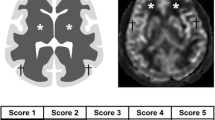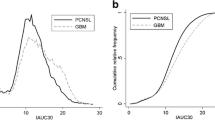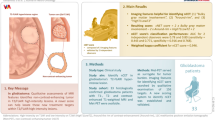Abstract
Objective
It is sometimes difficult to distinguish between primary central nervous system lymphomas (PCNSL) and glioblastoma multiforme (GBM). The aim of this study was to investigate whether the addition of 18F-2-fluoro-2-deoxy-d-glucose positron emission tomography ([18F]FDG-PET) and apparent diffusion coefficients (ADC) to conventional MRI improves diagnostic accuracy for distinguishing between PCNSL and GBM with similar MRI findings.
Methods
We used conventional- and diffusion-weighted MRI and FDG-PET scans of 21 patients with histologically confirmed brain tumors exhibiting similar MRI findings (PCNSL, n = 14, GBM, n = 7) in our observer performance study that consisted of 3 interpretation sessions. ADC and maximum standard uptake values (SUVmax) of the tumors were calculated. Three radiologists first interpreted conventional MRI (1st session), then they read images to which the ADC value had been added (2nd session), and finally they interpreted images supplemented with SUVmax (3rd session). Observer performance was evaluated using κ statistic and receiver operating characteristics analyses.
Results
The addition of ADC values to conventional MRI failed to improve the differentiation between PCNSL and GBM. The addition of SUVmax at the third session improved the diagnostic accuracy of all 3 readers and resulted in higher interobserver agreement; mean accuracy was 95% (range 93–100%). In one observer the accuracy of tumor differentiation was significantly improved at the third compared to the second session (p = 0.017).
Conclusions
In a selected group of PCNSL and GBM with similar MRI findings, the addition of quantitative FDG-PET to MRI may improve their differentiation. ADC measurement did not allow further discrimination.




Similar content being viewed by others
References
van der Sanden GA, Schouten LJ, van Dijck JA, van Andel JP, van der Maazen RW, Coebergh JW. Primary central nervous system lymphomas: incidence and survival in the Southern and Eastern Netherlands. Cancer. 2002;94:1548–56.
Olson JE, Janney CA, Rao RD, Cerhan JR, Kurtin PJ, Schiff D, et al. The continuing increase in the incidence of primary central nervous system non-Hodgkin lymphoma: a surveillance, epidemiology, and end results analysis. Cancer. 2002;95:1504–10.
Makino K, Nakamura H, Kino T, Takeshima H, Kuratsu J. Rising incidence of primary central nervous system lymphoma in Kumamoto, Japan. Surg Neurol. 2006;66:503–6.
Koeller KK, Smirniotopoulos JG, Jones RV. Primary central nervous system lymphoma: radiologic–pathologic correlation. Radiographics. 1997;17:1497–526.
Erdag N, Bhorade RM, Alberico RA, Yousuf N, Patel MR. Primary lymphoma of the central nervous system: typical and atypical CT and MR imaging appearances. AJR Am J Roentgenol. 2001;176:1319–26.
Coulon A, Lafitte F, Hoang-Xuan K, Martin-Duverneuil N, Mokhtari K, Blustajn J, et al. Radiographic findings in 37 cases of primary CNS lymphoma in immunocompetent patients. Eur Radiol. 2002;12:329–40.
Rees JH, Smirniotopoulos JG, Jones RV, Wong K. Glioblastoma multiforme: Radiologic-pathologic correlation. Radiographics. 1996;16:1413–38.
Toh CH, Chen YL, Hsieh TC, Jung SM, Wong HF, Ng SH. Glioblastoma multiforme with diffusion-weighted magnetic resonance imaging characteristics mimicking primary brain lymphoma. Case report. J Neurosurg. 2006;105:132–5.
Guo AC, Cummings TJ, Dash RC, Provenzale JM. Lymphomas and high-grade astrocytomas: comparison of water diffusibility and histologic characteristics. Radiology. 2002;224:177–83.
Yamasaki F, Kurisu K, Satoh K, Arita K, Sugiyama K, Ohtaki M, et al. Apparent diffusion coefficient of human brain tumors at MR imaging. Radiology. 2005;235:985–91.
Toh CH, Castillo M, Wong AM, Wei KC, Wong HF, Ng SH, et al. Primary cerebral lymphoma and glioblastoma multiforme: differences in diffusion characteristics evaluated with diffusion tensor imaging. AJNR Am J Neuroradiol. 2008;29:471–5.
Horger M, Fenchel M, Nägele T, Moehle R, Claussen CD, Beschorner R, et al. Water diffusivity: comparison of primary CNS lymphoma and astrocytic tumor infiltrating the corpus callosum. AJR Am J Roentgenol. 2009;193:1384–7.
Kosaka N, Tsuchida T, Uematsu H, Kimura H, Okazawa H, Itoh H. 18F-FDG PET of common enhancing malignant brain tumors. AJR Am J Roentgenol. 2008;190:W365–9.
Hanley JA, McNeil BJ. A method of comparing the areas under receiver operating characteristic curves derived from the same cases. Radiology. 1983;148:839–43.
Landis JR, Koch GG. The measurement of observer agreement for categorical data. Biometrics. 1977;33:159–74.
Rosenfeld SS, Hoffman JM, Coleman RE, Glantz MJ, Hanson MW, Schold SC. Studies of primary central nervous system lymphoma with fluorine-18-fluorodeoxyglucose positron emission tomography. J Nucl Med. 1992;33:532–6.
Hustinx R, Smith RJ, Benard F, Bhatnagar A, Alavi A. Can the standardized uptake value characterize primary brain tumors on FDG-PET? Eur J Nucl Med. 1999;26:1501–9.
Sasaki M, Yamada K, Watanabe Y, Matsui M, Ida M, Fujiwara S, et al. Variability in absolute apparent diffusion coefficient values across different platforms may be substantial: a multivendor, multi-institutional comparison study. Radiology. 2008;249:624–30.
Conflict of interest
The authors declare that they have no conflict of interest.
Author information
Authors and Affiliations
Corresponding author
Additional information
K. Makino and T. Hirai have contributed equally to this study.
Rights and permissions
About this article
Cite this article
Makino, K., Hirai, T., Nakamura, H. et al. Does adding FDG-PET to MRI improve the differentiation between primary cerebral lymphoma and glioblastoma? Observer performance study. Ann Nucl Med 25, 432–438 (2011). https://doi.org/10.1007/s12149-011-0483-1
Received:
Accepted:
Published:
Issue Date:
DOI: https://doi.org/10.1007/s12149-011-0483-1




